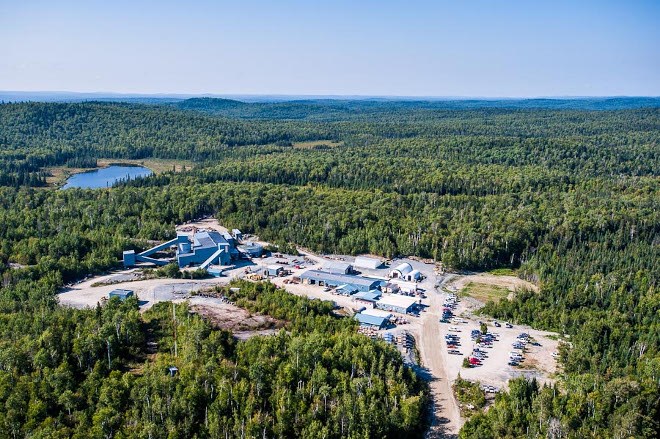What Alamos Gold has on its hands with its Island Gold Mine outside Dubreuilville is something unique and rare in geology and exploration discoveries.
At the recent BMO Global Metals and Mining Conference, company president-CEO John McCluskey was recently explaining the Toronto mining company's spectacular success with the underground mine and its endless high-grade gold potential, likely to extend the longevity of its current mine life beyond 14 years.
"The ore body has not been that difficult to figure out," McCluskey said. "It's been one consistent sheet and there's been very little... mystery to it. They (geology team) can pretty much pinpoint, from basically from 2,000 feet away on surface, where they're going to hit the ore body and actually hit it.
"Island Gold is a phenomenon. You'll be lucky to get one of these in your lifetime. Believe me, we feel very lucky to have it, but we don't think we've found the last ounce by any means."
Island Gold remains a growing, high-grade, low-cost asset and ranks as the sixth highest grade gold operation in the world.
Want to read more stories about business in the North? Subscribe to our newsletter.
McCluskey and the company lauded the strong performances and strong gold potential of their two northeastern Ontario operations, which includes the Young-Davidson Mine at Matachewan, in their fourth quarter and year-end results for 2021.
Young-Davidson Mine is evolving into the gold producing workhorse Alamos envisioned when it was acquired in 2015, while Island Gold is starting to look like a bottomless pit of high-grade gold.
Alamos acquired Island Gold in 2017 and is steering a third phase of mine expansion as the deposit has tripled in size over the last four years. From the initial 1.8 million ounces at the time of acquisition, Island Gold now boasts 5.1 million ounces in gold reserves and resources.
This past year, the mine's gold reserves and resources ticked up eight per cent.
The mine produced a steady 140,900 ounces last year and generated $53.1 million in free cash flow.
Sign up for the Sudbury Mining Solutions weekly newsletter here.
What's underpinned their success, McCluskey explained at the Feb. 28 conference, is their practice of annually budgeting $20 million to $25 million toward an aggressive exploration program there.
This year, out of Alamos' entire $40-million exploration budget, $22 million is earmarked for Island Gold.
The third wave of mine expansion at Island Gold is expected to drive a 70 per cent increase in production, to 236,000 ounces, when the project is done in 2025. Associated with the $500-million project is the sinking of a new mine shaft in an area of exploration on their property called Island East.
Since a Phase 3 mine study came out out in 2020, Alamos has added 1.5 million ounces reserves and resources. That'll be incorporated into an updated mine plan due out this year.
"We're encountering some of the best grades that we've ever seen at the mine, as we drill in this area," said McCluskey, which is showing high-grade gold that's open both laterally and deeper down.
One drill hole, sent 240 metres down plunge at Island East, yielded 12 grams of gold over a five-metre core length, which is "a great confirmation that the ore body is going to continue," he said.
It's those kind of results, McCluskey said, that stokes their confidence in building ounces for some time to come.
To the east, Young-Davidson, the company's anchor operation, achieved record mine rates and cash flow of $100.3 million last year. The mine produced 195,000 ounces in 2021, up 43 per cent from the previous year.
McCluskey said Young-Davidson, one of Canada's largest underground mines, has been "under the microscope" from the time Alamos bought it in 2015 to the completion of the lower mine expansion in 2020.
That project was an optimization process to increase production from 6,000 tonnes per day to 8,000 tonnes.
It upgraded and streamlined multiple ore-handling systems into one, feeding ore from stope to shaft, and resulted in a huge reduction in costs per tonne, from $55 to $43. Through exploration, they've tacked on two more years of production from the main ore body, extending gold reserves out from 13 to 15 years.
Young-Davidson is situated along the Cadillac Larder Lake break, a famous area of Ontario that's host to some of the highest grade mines in the province.
McCluskey said they pushed out a drift to begin drilling from underground and are getting some encouraging results. And there's more to be discovered as the company said more gold potential appears to exist below the existing mine infrastructure, suggesting the deposit extends downward, and they've encountered more high-grade gold upside in the hanging wall and footwall of the deposit.
Besides Island Gold and Young-Davidson Mine, Alamos operates the Mulatos Mine in the Mexican state of Sonora, along with a pipeline of mine development projects in Canada, the U.S., Mexico and Turkey.




